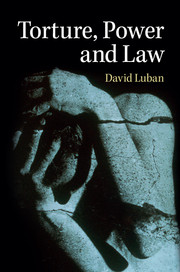Book contents
- Frontmatter
- Dedication
- Contents
- Preface
- Acknowledgments
- I Downgrading rights and expanding power during post-9/11 panic
- II The ticking bomb as moral fantasy and moral fraud
- III The evils of torture
- 5 A communicative conception of torture
- 6 Human dignity, humiliation, and torture
- 7 Mental torture: a critique of erasures in US law
- IV Complicity in torture
- Main index
- Index of legal authorities
- References
7 - Mental torture: a critique of erasures in US law
Published online by Cambridge University Press: 05 September 2014
- Frontmatter
- Dedication
- Contents
- Preface
- Acknowledgments
- I Downgrading rights and expanding power during post-9/11 panic
- II The ticking bomb as moral fantasy and moral fraud
- III The evils of torture
- 5 A communicative conception of torture
- 6 Human dignity, humiliation, and torture
- 7 Mental torture: a critique of erasures in US law
- IV Complicity in torture
- Main index
- Index of legal authorities
- References
Summary
Introduction
As flies to wanton boys, are we to th’ gods,
They kill us for their sport.
John McCain’s bones may have been broken, but his spirit never was.
Torture can be psychological as well as physical. Prolonged isolation, sensory deprivation, humiliation and sexual degradation, close confinement in coffin-like boxes, and threats to you or those you love all produce horrific mental suffering. The forms it takes are hardly mysterious, and we can describe them in everyday language as well as psychiatric categories: despair, loneliness, disorientation, terror, depression, confusion, claustrophobia, anxiety, and loss of personality. Mental suffering may take the form of clinically recognized psychiatric conditions like post-traumatic stress disorder (PTSD), but it need not.
Both US and international law recognize that torture can be psychological as well as physical. The UN Convention Against Torture and Other Cruel, Inhuman or Degrading Treatment or Punishment (CAT) defines torture as “severe pain or suffering, whether mental or physical,”3 and the US torture statute likewise recognizes that “severe physical or mental pain or suffering” intentionally inflicted by government agents constitutes torture, a crime that carries sentences from twenty years to life.4 The similarity is no coincidence: the statute represents Congress’ implementation in 1994 of CAT, as required by Article 4 of the convention. The convention and the US torture statute also specify mens rea and circumstance in their definitions of the crime of torture, but the “severe physical or mental pain or suffering” formula is the definitional core of what it is that torturers inflict on their victims.
- Type
- Chapter
- Information
- Torture, Power, and Law , pp. 153 - 194Publisher: Cambridge University PressPrint publication year: 2014



